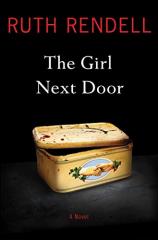The Girl Next Door
Review
The Girl Next Door
A word of warning: If you go into Ruth Rendell's THE GIRL NEXT DOOR with the expectation that it will be a typical mystery novel, or even a typical novel of psychological suspense, you're likely to be disappointed. What Rendell does in her latest book falls outside either of these categories, although it contains elements of both. Instead, it is more like a group portrait --- or even a longitudinal study, fictional of course --- of a group of disparate people and how a long-buried secret brings them back together, for better or for worse.
The book is not exactly a mystery, for readers know from the very first chapter not only what the crime is, but also its perpetrator. Enraged by his wife's infidelity, a young husband murders her and her lover, destroying their bodies, but not before severing their hands and placing them in a biscuit tin, burying the tin in a series of tunnels near their property in exurban London. The time is World War II, and the murderer takes advantage of the upheaval of wartime to cover up his crime, claiming, credibly enough, that his wife and her lover have both gone missing, presumably to start new lives elsewhere, as many people did during and after the war.
"Neither a mystery nor a typical story of suspense, THE GIRL NEXT DOOR nevertheless holds more than a few surprises for readers, right up until the end."
Fast forward to the present day, and a new construction project uncovers that buried biscuit tin --- and the skeletal remains inside it. The police open an investigation more out of a sense of obligation than of urgency, but they do bring together a group of people, now in their 70s, who were once children and played together in those underground tunnels. Many of them haven't seen each other in 50 years or more. Rosemary and her husband, Alan, were children together in the tunnels and later rekindled their friendship (which became a romance) as young adults. However, when the two of them are reunited with their old playmates, particularly the provocative Daphne, their lives change more than any of them would have predicted.
Reading THE GIRL NEXT DOOR brings to mind how remarkable it is to see older adults portrayed in fiction not only as fully developed, complex characters, but as characters with sex lives and sexual desires. This portrayal is both surprising and refreshing (albeit in the context of marital infidelity). Rendell illustrates that love triangles and romantic betrayal can spark passion, irrationality and revenge in young and old, men and women alike. But she also reminds readers of any age that older adults are fully capable of emotional growth and genuine change, even at a time when their life's pattern seems set in stone.
Neither a mystery nor a typical story of suspense, THE GIRL NEXT DOOR nevertheless holds more than a few surprises for readers, right up until the end. Complex, emotional and often unexpected, it shows that Rendell still has the ability to change readers' points of view and keep them on the edge of their seats.
Reviewed by Norah Piehl on October 10, 2014
The Girl Next Door
- Publication Date: October 7, 2014
- Genres: Fiction, Psychological Suspense, Psychological Thriller, Suspense, Thriller
- Hardcover: 288 pages
- Publisher: Scribner
- ISBN-10: 1476784329
- ISBN-13: 9781476784328





